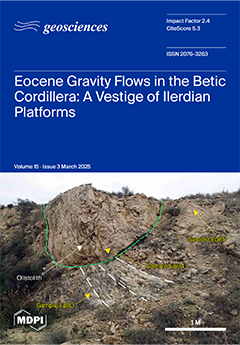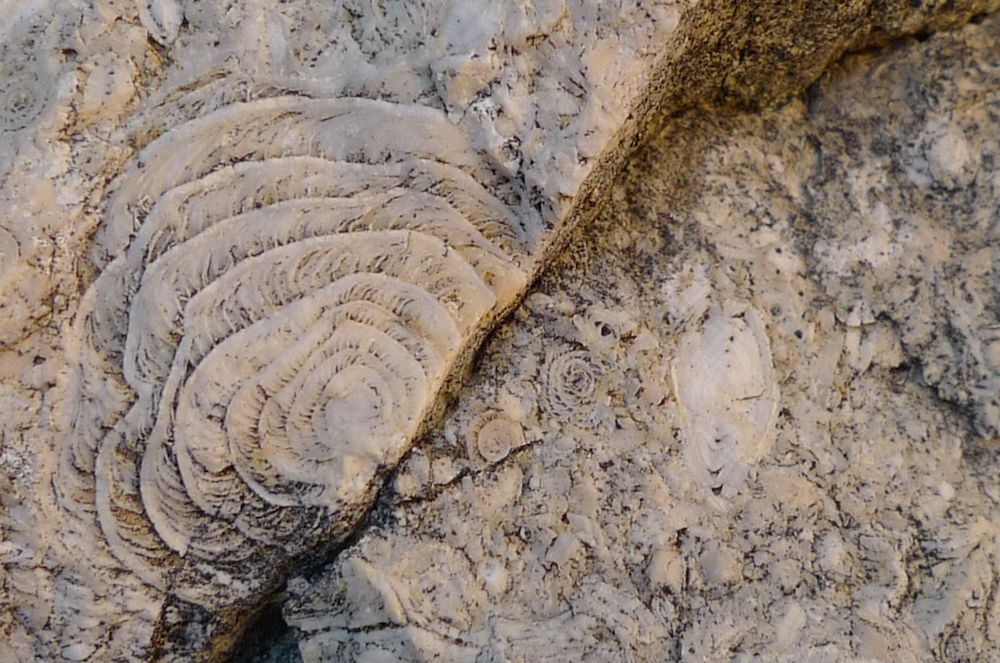Home » 2025
Yearly Archives: 2025
Geosciences, Volume 15, Issue 3 (March 2025)
The march issue of the Geoscience journas has a cover story dealing with the newly published paper in that issue by Tosquella et al. (2025) of our group. In the Betic-Rif Cordilleras the Eocene platforms started in the Cuisian after a gap including the Ilerdian. An Eocene succession with gravity flows consisting of turbidites and olistostromes was detected in the Aspe-Terreros Prebetic section (External Betic Zone). In one of the turbidites, we dated the middle Ilerdian, on the basis of LBF, representing a vestige of a missing Illerdian carbonate platform. The microfacies of these deposits rich in LBF have been described and documented. The gap in the sedimentation and absence of Ilerdian platforms in the Betic-Rif have been related to the so-called Eo-Alpine tectonics (Cretaceous to Paleogene) and sea-level variations contemporarily with the establishment of shallow marine realms in the western Tethys.

Paleocene-Eocene evolution of the Prebetics (South Spain) and comparison with other western Tethyan margins
Thirteen Paleocene-Eocene sections have been studied along the Prebetic Domain (South Iberian Margin) in the Alicante, Murcia, Granada, and Jaen Sectors. The sedimentary realms (mostly consisting in 15 shallow marine Lithofacies) and the tectono-sedimentary evolution were characterized. Three informal stratigraphic units were proposed and dated with planktic foraminifera, calcareous nannoplankton, and Larger Benthic Foraminifera (LBF): (1) lower marly-clayey fm; (2) intermediate limestone-calcarenite fm; and (3) upper marly-clayey fm. The stratigraphic architecture shows diachronous boundaries and lateral passages, representing the internal and external platform (upper slope in a few cases). The lower marly-clayey fm is upper Paleocene to middle Lutetian, the intermediate limestone-calcarenite fm ranges from lower Ypresian to lower Bartonian, while the upper marly-clayey formation is lower Lutetian to lower Priabonian. The diachronism can be due to the inherent sedimentary paleoenvironment changes and to climatic-tectonic interferences. The noticeable thickness variations of sedimentary successions in the studied sections could indicate a synsedimentary tectonics with upward and downward movements of blocks or folds. During the Paleocene-Eocene, the studied area was part of the meridional belt of platforms in the western Tethys. A comparison with other sectors of the central-western Mediterranean area has been performed to evidence synchronous events at Tethyan scale. The compared margins experienced a common pre-foredeep evolution affected by the Eo-Alpine tectonics (Cretaceous to Paleogene) contemporaneously to the establishment of shallow and deep palaeoecological realms. In the case of shallow sedimentary successions, LBF and corals are registered. Comparable gaps in sedimentation are recorded in most of the correlated domains.

Detrital signatures of the Ghomaride Culm cycle in Northern Morocco
The Carboniferous detrital suites of the Ghomaride Subdomain (Rif Cordillera, N Morocco) has been undertaken in order to obtain paleogeographic and paleotectonic constraints. Microconglomerate and sandstone samples from eight sections belonging to four sectors were petrographically studied. This northern Gondwana domain was part of the Paleo-Mesomediterranean Plate, located between the Iberian-French Plates and the African Paleo-Atlas-Saharian Domain, which outlines a gap of knowledge since these domains are now part of the Alpine peri-Mediterranean chains. Part of this data-lacking is related to the sandstone detrital modes that have never studied in this area, allowing to obtain information about provenance derived from growing orogens, as well as orogenic processes, and tectonic, climatic and/or erosional events. The study has revealed that the sandstones are litharenites to feldsphatic litharenites, evolving upward to lithic arkoses, and has evidenced a quartzolithic petrofacies with a transitional recycled orogen provenance. The metamorphic clastic detritus displays a low to middle-upper metamorphic rank upwardly referred to a subducted terrane. Serpentinite-like detritus indicates a metamorphosed oceanic crust being dismantled. A supply from the Rheic Ocean seems improbable since it was very far and beyond the Iberian Plate. Therefore, closer oceanic sutures should be proposed, probably separating the Paleo-Mesomediterranean Plate from the Iberian-French Plate and from the Paleo-Atlas-Saharian Domain. The syn-sedimentary volcanic activity (felsic to mafic) reinforces the idea of subductions. A correlation with other Culm successions of the western Paleotethys has allowed the performing of a paleogeographic-paleotectonic model during the Paleotethysian tectonic phase, in which the studied sandstones were deposited in a foredeep connected northward with limestone platforms and with a crystalline emerged domain (hinterland-orogenic front: Iberia-French Plate and part of the Paleo-Mesomediterranean Plate) and transitioning southward to an oceanic branch of the western Paleotethys, and finally with the Paleo-Atlas-Saharian band acting as passive margin in the foreland.

A) Paleogeographic sketch of the western Mediterranean area during the late Cretaceous (after Guerrera and Martín-Martín, 2014) with the location of the Mesomediterranean Microplate (in brown color) and the Ghomaride subdomain (in yellow color) as well as the Malaguide, Kabylide, Calabria-Peloritani and Tuscany domains; B) sketch map with the location of the Internal Zones of the Western Perimediterranean Alpine chains (in brown color) derived from the Mesomediterranean Microplate in the left figure. The outcroppings of the Ghomaride subdomains in the Rif Cordillera (in yellow color) are also positioned.
Recent Comments